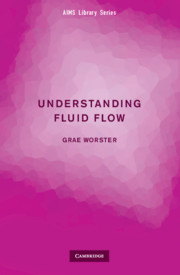4 - Equations of flow
Published online by Cambridge University Press: 30 April 2024
Summary
The Navier–Stokes momentum equation
So far we have used one-dimensional and quasi-one-dimensional examples to explore some of the physical forces acting on the interior of fluids. It is now time to meet the general equations for three-dimensional fluid flow. The vector momentum equation, also called the Navier–Stokes momentum equation, is
We can recognize all the terms in this equation from what we have seen before. The term on the left-hand side represents the rate of change of the momentum of a fluid particle, with the operator D/Dt (called the material derivative) denoting the rate of change with time following the particle. On the right-hand side are terms expressing the forces on a fluid particle: the pressure gradient; the divergence of viscous stresses; and the force of gravity per unit volume. Derivation of the stress term requires an analysis of the microscopic stress tensor of the fluid, and assumptions that the fluid is both incompressible and isotropic (having properties independent of the direction along which they are measured). The second-rank stress tensor σ is defined such that the stress exerted by a fluid on a surface with unit normal n pointing into the fluid is given by
We shall not discuss this further here, but will rather use examples to develop an understanding of the various terms in the Navier–Stokes momentum equation.
The material derivative
There are many different ways of describing fluid flows or of visualising them in the laboratory. One way is to place a tracer in the fluid. For example, we could release a buoy somewhere in the ocean and track its subsequent position as a function of time. This gives a so-called Lagrangian picture of fluid flow, assuming that the tracer follows the flowexactly. Dependent variables, such as the velocity of a fluid particle, are given as functions of time t and the initial position x0 of the particle. We can therefore write
Such a description gives us some sense of a flow: we might notice that some Lagrangian tracers in a river stay swirling around in eddies without going far from their original positions while others meander all the way downstream to the sea. However, it is not hard to imagine that different particle trajectories can become tangled in each other. In fact, even a single trajectory in a steady three-dimensional flow can be chaotic.
- Type
- Chapter
- Information
- Understanding Fluid Flow , pp. 37 - 62Publisher: Cambridge University PressPrint publication year: 2009

